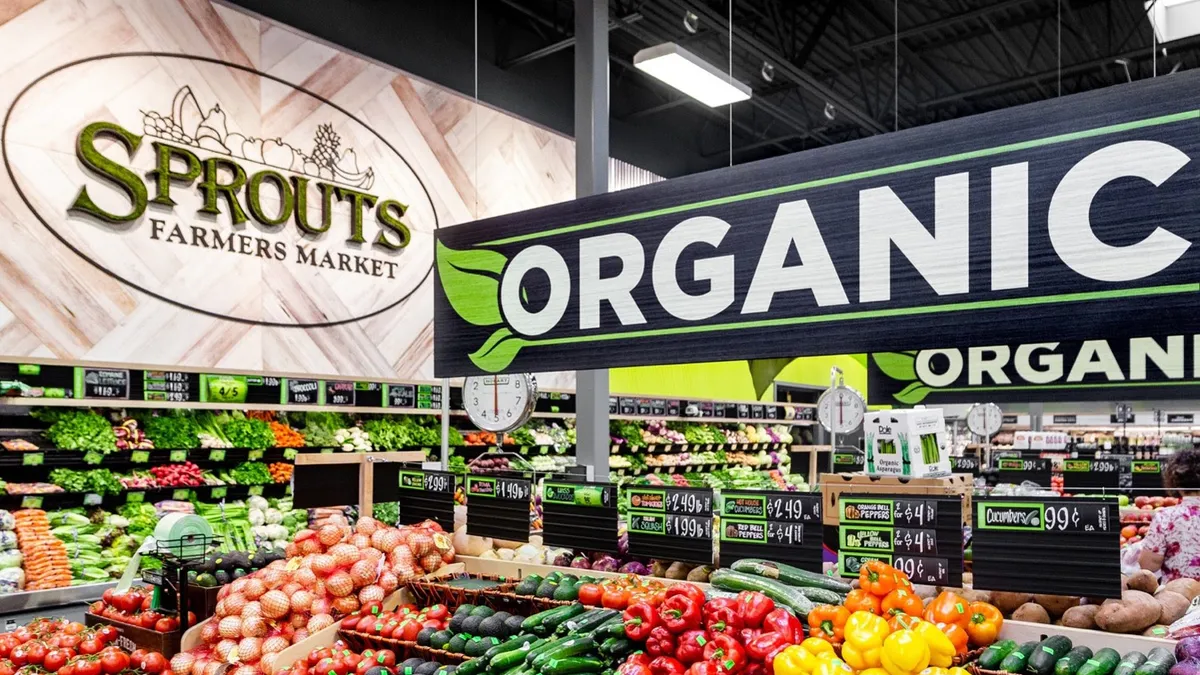Dive Brief:
- Sprouts Farmers Market made significant progress during the fourth quarter in its efforts to encourage online customers to use the company’s own e-commerce platform to place orders, directing 15% of its digital traffic through that route, chief financial officer Denise Paulonis said during the company’s earnings call Thursday. The grocer recorded a more than 290% increase in online sales in Q4 on a year-over-year basis, Paulonis said.
- The chain’s net sales rose 17% during Q4, to $1.6 billion, and comparable sales growth during the period came in at 3.7%, down from 4.2% in the previous quarter. Net sales in 2020 hit $6.5 billion, a 15% increase over 2019.
- Sprouts is looking to digital marketing and the smaller, more-focused store format it is getting ready to roll out to push its business forward during 2021 and beyond.
Dive Insight:
Executives at Sprouts have made clear over the past year that they feel the company has a long runway ahead and needs only to secure a fraction of the customers in its target markets to drive significant growth. Paulonis and Chief Executive Officer Jack Sinclair refined that theme as they described their vision for Sprouts over the year ahead during Thursday's earnings call.
Paulonis underscored the value to Sprouts of being able to control the relationship with online customers by handling transactions on its own systems rather than a third-party e-commerce platform. The company has only had that capability since late in Q3, but it has made a clear difference, Paulonis said, noting that Sprouts ended 2021 with e-commerce penetration of about 11%. Sprouts’ e-commerce sales were up 340% in 2020 compared with 2019.
“We're really pleased to see that level of penetration in that area so quickly ... Instacart is a great partner, but we're happy to have another alternative for our customer to just be directly in our ecosystem,” she said.
Paulonis said customers have been buying a wider range of products online than they had in the past, although items like produce and vitamins still tend to generate more sales in stores. The typical Sprouts e-commerce basket is roughly twice the size of the chain’s average in-store order size, which Paulonis said is “somewhere in the low 40s” in terms of number of items. Gross margins across the chain’s online and in-store segments are comparable, she said.
“E-commerce business isn't as naturally profitable as the in-store business for us, [but] it is nicely profitable, heavily driven by the size of that basket coming through. So to us every order is a good order,” Paulonis said.
While Sprouts saw remarkably strong digital growth in 2020, Paulonis and Sinclair said that trend is likely to stall as the nation’s COVID-19 vaccination effort gains momentum. Sprouts expects digital sales in 2022 will be above their level in 2019, “but nothing like the level that it got to in 2020,” Sinclair said.
Sinclair said that the company’s ability to open new stores was held back in 2020 by the pandemic and is also likely to be slower than he would like in 2021. Sprouts debuted 22 locations in 2020 and plans to open about 20 more this year.
Sprouts hopes to be able to open “substantially more than 20 stores a year” in 2022 and 2023, which would be in line with the chain’s annual fleet growth target of about 10%, according to Sinclair.
Sprouts will begin to transition to its previously announced smaller store format this summer, when the chain intends to open its first location based on the new design in Phoenix, where it is based, Sinclair said. Some of the other stores Sprouts plans to open this year will also reflect the new design, he said.
Starting in 2022, all of Sprouts’ new stores will follow the revised format, which retains the company’s central produce section and farmers market aura in a box of 25,000 square feet or less. The updated design also dispenses with non-productive space, allowing it to accommodate a similar number of SKUs as the existing format.
Sinclair added that Sprouts is on track to open two new fresh distribution centers this year, in Colorado and Florida, bringing its total to seven. The addition of the new facilities, which will include features like ripening rooms, will get Sprouts closer to its goal of having stores within 250 miles of a distribution center and expanding its selection of local produce, according to Sinclair.
As it looks to expand its physical facilities, Sprouts is also stepping up efforts to connect with customers electronically. The pandemic enabled the company to sharply accelerate its switch from print to digital marketing in 2020, and it expanded its customer email database by 50% during the year, to more than 3 million addresses, according to Sinclair. Downloads of the grocer’s mobile app surged almost 60% in 2020, he said.
Sinclair also said he thinks customers are likely to remain averse to purchasing food from self-service stations like salad and olive bars even as the pandemic recedes due to safety concerns.
“It's been a part of our business, but not a huge part and we're thinking very hard about how to do that effectively. I don't think it'll get anything like back to where it was.” Sinclair said. “I think the whole health and hygiene issue is … going to be a thing that's going to be here for years.”













